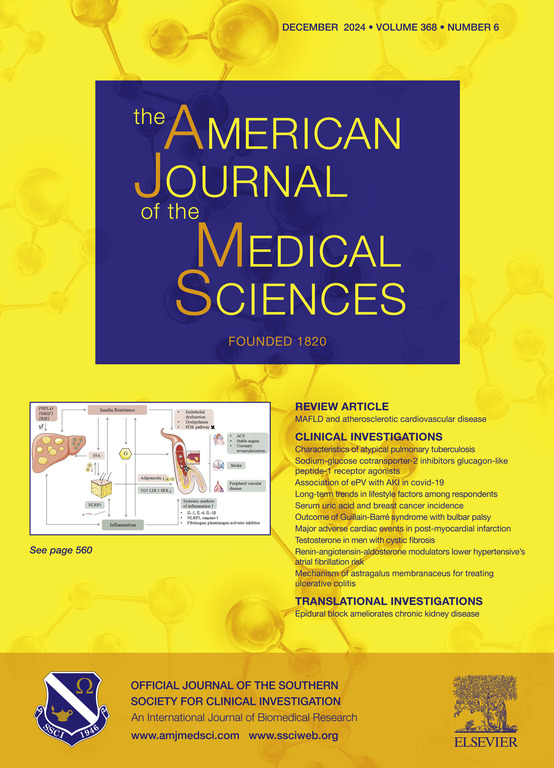The TyG index correlation with invasive ventilator in critically ill patients: A retrospective analysis of the MIMIC-IV database
IF 2.3
4区 医学
Q2 MEDICINE, GENERAL & INTERNAL
引用次数: 0
Abstract
Background
Insulin resistance is common in critically ill patients. It is not known whether it is associated with the use of invasive ventilation. This study investigated the relationship between the triglyceride glycemic index (TyG) and the risk of invasive ventilator use in critically ill patients admitted to the intensive care unit (ICU).
Methods
The study utilized the Medical Information Mart for Intensive Care-IV database. All patients were divided into three groups according to the TyG index. The study employed univariable and multivariable logistic regression analysis, competing risk analysis, and 4-knot multivariate restricted cubic spline regression. ROC curves were used to determine if the TyG index improves the predictive value of disease scores.
Results
Out of 2196 participants, 51.9 % had invasive ventilation. Multivariable logistic regression analyses and competing risk analyses revealed that the risk of Invasive ventilator use was significantly higher in the highest quartile of the TyG index. Meanwhile, the RCS analysis indicated S-typed relationships between the TyG index and invasive ventilator use, with inflection points at 9.40, respectively. The TyG index had an incremental effect on the AUC of existing severity of illness scores to predict invasive ventilation.
Conclusions
This study shows that an increased TyG index is a significant risk factor for invasive ventilation in patients in the ICU.
危重患者TyG指数与有创呼吸机的相关性:对MIMIC-IV数据库的回顾性分析。
背景:胰岛素抵抗在危重患者中很常见。目前尚不清楚这是否与使用有创通气有关。本研究探讨了重症监护病房(ICU)危重患者甘油三酯血糖指数(TyG)与有创呼吸机使用风险的关系。方法:利用重症监护医学信息集市- iv数据库进行研究。根据TyG指数将所有患者分为三组。本研究采用单变量和多变量logistic回归分析、竞争风险分析和4节多变量限制性三次样条回归。使用ROC曲线来确定TyG指数是否提高了疾病评分的预测值。结果:在2196名参与者中,51.9%的人进行了有创通气。多变量logistic回归分析和竞争风险分析显示,在TyG指数最高的四分位数中,使用有创呼吸机的风险显著更高。同时,RCS分析显示TyG指数与有创呼吸机使用呈s型关系,拐点分别为9.40。TyG指数对现有疾病严重程度评分的AUC具有增量效应,可用于预测有创通气。结论:本研究提示TyG指数升高是ICU患者有创通气的重要危险因素。
本文章由计算机程序翻译,如有差异,请以英文原文为准。
求助全文
约1分钟内获得全文
求助全文
来源期刊
CiteScore
4.40
自引率
0.00%
发文量
303
审稿时长
1.5 months
期刊介绍:
The American Journal of The Medical Sciences (AJMS), founded in 1820, is the 2nd oldest medical journal in the United States. The AJMS is the official journal of the Southern Society for Clinical Investigation (SSCI). The SSCI is dedicated to the advancement of medical research and the exchange of knowledge, information and ideas. Its members are committed to mentoring future generations of medical investigators and promoting careers in academic medicine. The AJMS publishes, on a monthly basis, peer-reviewed articles in the field of internal medicine and its subspecialties, which include:
Original clinical and basic science investigations
Review articles
Online Images in the Medical Sciences
Special Features Include:
Patient-Centered Focused Reviews
History of Medicine
The Science of Medical Education.

 求助内容:
求助内容: 应助结果提醒方式:
应助结果提醒方式:


